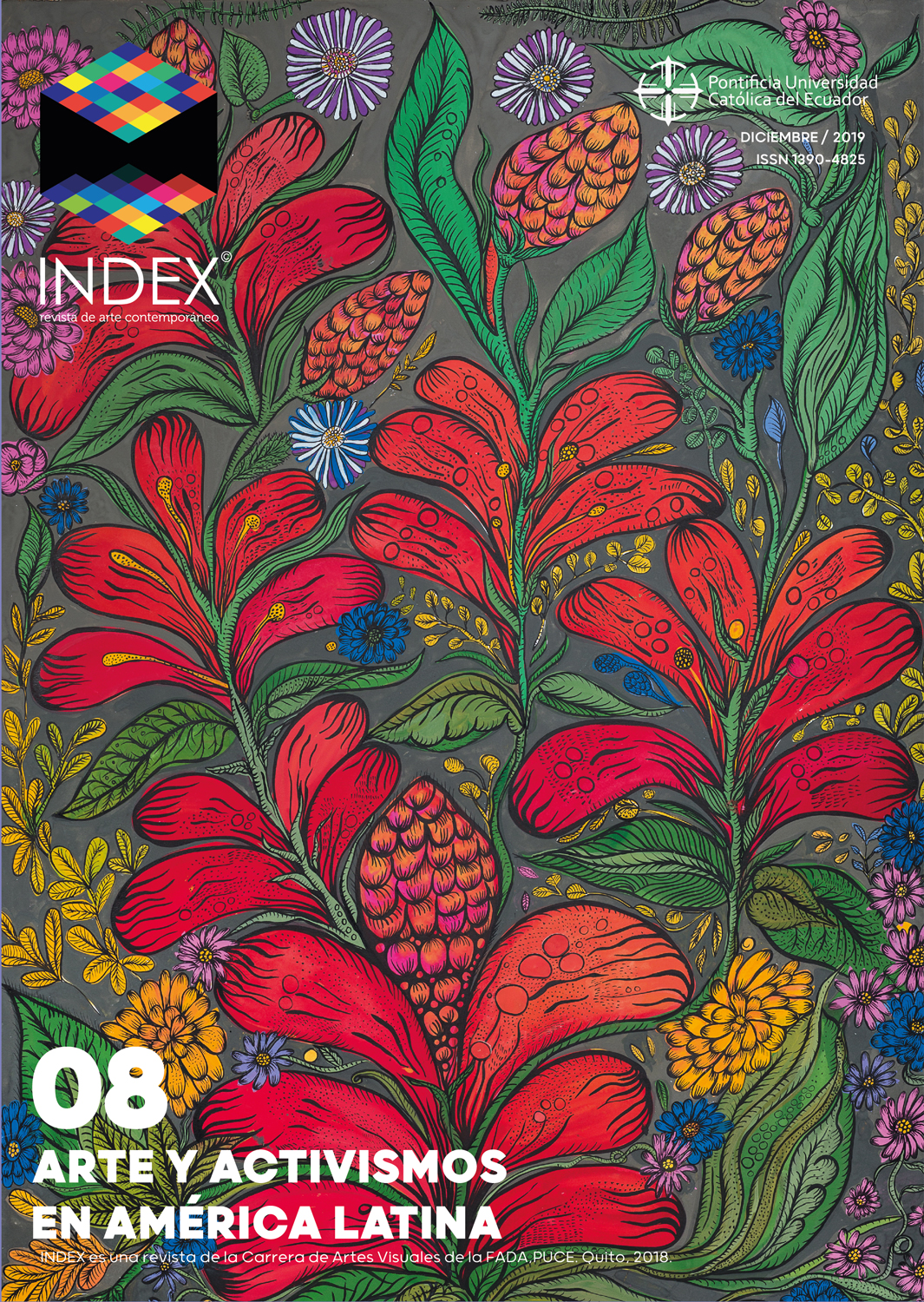Between digital art and political activism Experiments of electronic sociability during Neoliberal Mexico (1994-2018)
Main Article Content
Abstract
Since the Zapatista uprising in Mexico in 1994, some digital practices have tested forms of sociability in which the distinctions between digital art and political activism are blurred. In this article, we will focus on notoriously different cases, such as Mejor Vida Corp. (1998), sitio*TAXI (2004), El Rancho Electrónico (2013) or Telecomunica-ciones Indígenas Comunitarias (2016), that during the rise of Neoliberalism in Mexico and its trend towards privatizing telecommunications, have engaged in specific ways of producing forms of sociability digitally mediated. We propose the commons as a key concept for understanding the singularity of these processes of sociability, which allows us to describe how experimental social relations are produced and maintained in the midst of market capitalism. As a conclusion, we will underline that, in these processes of digital communicating community is not assumed as a presupposition, but rather as an uncertain result of digital mediations.
Downloads
Article Details
Index, revista de arte contemporáneo maneja sus derechos bajo licencia Creative Commons Reconocimiento-NoComercial 4.0. En ese sentido los envíos quedan sujetos a la decisión del autor.
References
Astrovandalistas. (2017). Somos. Recuperado de http://astrovandalistas.cc/somos/.
Centro Multimedia. (2009). Centro Multimedia. Centro Nacional de las Artes. Quince Años. México: Conalcuta.
Cleaver, H. (1998). The Zapatista Effect: The Internet and the Rise of an Alternative Political Fabric. Journal of International Affairs, 51(2), 621-640.
Conant, J. (2010). A Poetics of Resistance. The Revolutionary Public Relations of the Zapatista Insurgency. Oakland: AK Press.
Cuevas, M. y Abaroa, E. (2013). Corporatocracy, Democracy and Social Change (in Mexico and Beyond). A Conversation on Art and Life. Third Text, 27(1), 162"“171.
Di Castro, A. (2006). Art and New Technology in Mexico: The National Center for the Arts. Leonardo 39(4), 371-372.
Eagleton-Pierce, M. (2001). The Internet and the Seattle WTO Protests. Peace Review 13(3), 331-337.
El Rancho Electrónico. (2017). ¿Qué es El Rancho Electrónico?. Recuperado de https://ranchoelectronico.org/faq/#%C2%BFQu%C3%A9-es-el-Rancho-Electr%C3%B3nico
Fuchs, C. (2017). Social Media: A Critical Introduction. London: Sage Publications.
Gerbaudo, P. (2012). Tweets and the Streets: Social Media and Contemporary Activism. London: Pluto Press.
Gómez Durán, T. (2017). Resistencia organizada y caminos alternativos. En A. Martínez. (Coord.), Derechos digitales en México: ganadores y perdedores de la reforma en telecomunicaciones (pp. 17-27). Ciudad de México: Horizontal.
Hess, Ch. (Julio de 2008). Mapping the New Commons. En The Twelfth Biennial Conference of the International Association for the Study of the Commons. Cheltenham.
Jasso, K., y Garza Usabiaga, D. (Eds.). (2010). (Ready) Media: Hacia una arqueología de los medios y la invención en México. México: Laboratorio de Arte Alameda, INBA & Conalcuta.
Lane, J. (2003). Digital Zapatistas. The Drama Review, 47(2), 129-144.
Linebaugh, P. (2014). Stop! Thief: The Commons, Enclosures and Resistance. Oak: Pm Press.
López Cuenca, A. (2014). La ruta está siendo recalculada. El motoboy y la economía política del afecto. En R. Parés. (Ed.), Antoni Abad. megafone.net/2004-2014 (pp. 44-45) Barcelona: Turner/Macba.
Magallanes Blanco, C., y Rodríguez Medina, L. (2016). Give Me a Mobile and I Will Raise a Community. En L. Robinson, J. Schulz, H. S. Dunn (Eds.), Communication and Information Technologies Annual (315-343). Studies in Media and Communications 12.
Martínez-Torres, M. (2001). Civil Society, the Internet, and the Zapatistas. Peace Review 13(3), 350-351.
Martínez Velázquez, A. (Coord.). (2017). Derechos digitales en México: ganadores y perdedores de la reforma en telecomunicaciones. Ciudad de México: Horizontal. Recuperado de http://horizontal.mx/wp-content/uploads/2017/01/informe2016-web-pages.pdf
Morozov, E. (2011). The Net Delusion. The Dark Side of Internet Freedom. Nueva York: Public Affairs.
Ostrom, E. (1990). Governing the commons: The Evolution of Institutions for Collective Action. New York: Cambridge University Press.
O"™Toole, G. (2003). A New Nationalism for a New Era: The Political Ideology of Mexican Neoliberalism. Bulletin of Latin American Research, 22(3), 269-290.
Parés, R. (Ed.). (2014). Antoni Abad. megafone.net/2004-2014. Barcelona: Turner/Macba.
Rhizomática. (2017). About Rhizomática. Recuperado de https://www.rhizomatica.org/about/.
Rivera Hernández, R. (Ed.). (2016). Del Internet a las calles: #YoSoy132, una opción alternativa de hacer política. Raleigh: Editorial a Contracorriente.
Rowan, J. (2016). Cultura Libre de Estado. Madrid: Traficantes de Sueños.
Sassen, S. (2006). Electronic Networks, Power and Democracy. Tailoring Biotechnologies 2(2), 21-48.
Slack, Daryl J., & Macgregor Wise, J. (2006). Cultural Studies and Communication Technology. En L. A. Lievrouw, y S. Livingstone (Eds), Handbook of New Media. Social Shaping and Social Consequences of ICTs (143-158). Londres, Thousand Oaks & New Dehli: Sage Publications.
Stalbaum, B. (2017). The Zapatista Tactical FloodNet. A collaborative, activist and conceptual art work of the net. Recuperado de https://www.thing.net/~rdom/ecd/ZapTact.html.
Subirats, J., y Rendueles, C. (2016). Los (bienes) comunes. ¿Oportunidad o espejismo? Barcelona: Icaria.
Wolf, M. Rhizome.org. Art Libraries Journal, 31(1) (2006), 47-48.

